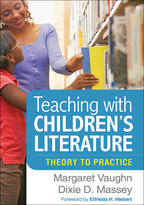Teaching with Children's Literature
Theory to Practice
Margaret Vaughn and Dixie D. Massey
Foreword by Elfrieda H. Hiebert
“There is so much for children to learn, and literature is the gateway to that learning. From text structure to character motivations, children’s literature provides opportunities for students to question, explore, and experience. This book shows us how it is done—how we can develop students’ thinking as we select the materials they will read.”
—Douglas Fisher, PhD, Department of Educational Leadership, San Diego State University
“Vaughn and Massey help teachers consider their beliefs about texts, tasks, and readers toward the goal of cultivating students' agency. What is especially masterful is the authors' ability to clearly and succinctly address the relevant theories that influence teacher decision making and classroom instruction. The book provides numerous activities and vignettes to illustrate the possibilities for purposeful instruction using children's literature. This is an invaluable resource for guiding the new learning of preservice teachers and supporting the continued learning of inservice teachers.”
—Denise N. Morgan, PhD, Literacy Education, Kent State University
“This is the quintessential text for either a preservice or master's-level course in children’s literature. Vaughn and Massey highlight the importance of developing agentic readers by providing choice and access to high-quality, culturally responsive children’s literature. Each chapter is well developed and offers an excellent blend of theory and practice. The content in each chapter is followed by a series of reflective exercises that help readers take action on the ideas presented. No matter where teachers may be in their careers, this book will help them be more intentional and thoughtful about the most important thing their students do—read!”
—C. C. Bates, PhD, Associate Professor of Literacy Education and Director, Reading Recovery and Early Literacy Training Center for South Carolina, Clemson University
"The authors acknowledge the complexity of teaching literacy and include both theoretical and practical considerations that teachers must weigh when making instructional decisions. The book describes specific instructional approaches, like interactive read-alouds, Reader’s Theatre, and teaching informational text structure, while 'keeping the main thing the main thing'—immersing students in relevant, relatable children’s literature. I plan to use this text in my undergraduate elementary reading methods course. I look forward to using the case studies and guiding questions to engage my students in discussions about the major themes of each chapter and to help them develop their vision for teaching literacy.”
—Erika S. Gray, PhD, Senior Lecturer, Department of Teacher Education and Higher Education, University of North Carolina at Greensboro
Table of Contents
Foreword, Elfrieda H. Hiebert
1. Introduction: Beliefs about Children’s Literature 
2. What Is Purposeful Teaching with Literature?
3. What Matters When Teaching with Literature in the Classroom?
4. What Do Books Have to Offer?
5. How Can We Help Students Understand the Books They Read?
6. How Can We Encourage Students to Read Widely?
7. How Can We Incorporate Expository Text Purposefully?
8. How Can We Use Writing and Discussing to Make Sense of Reading?
9. How Can We Encourage Reading Beyond the Classroom?
10. How Do We Put It All Together?
Appendix A. Books to Support Student Agency
Appendix B. Books to Talk about Visioning with Students
Appendix C. Books by Genre
Appendix D. Book Awards
Appendix E. Popular Series Books
Appendix F. Book Club Choices
Appendix G. Children’s and Teen Choice Awards
References
Children’s Literature
Children’s Literature by Appendix
Index
About the Authors
Margaret Vaughn, PhD, is Professor in the Department of Teaching and Learning at Washington State University. She teaches in the program areas of Research and Literacy, Language, and Technology. As a former classroom teacher, Dr. Vaughn recognizes the valuable role of teacher input and decision making in policy and practice and supports efforts to develop equity-focused learning environments. She is an advocate for student agency and developing equitable schools across the nation. Her award-winning research addresses issues of teacher practice and contemporary educational issues. Dr. Vaughn is coeditor of Principles of Effective Literacy Instruction, Grades K–5, and coauthor of Accelerating Learning Recovery for All Students andDixie D. Massey, PhD, is a lecturer at Seattle Pacific University, where she teaches courses in literacy development and teacher preparation. Dr. Massey is coauthor of several curriculum books and series. She has published her research in leading journals of literacy research and practice.
